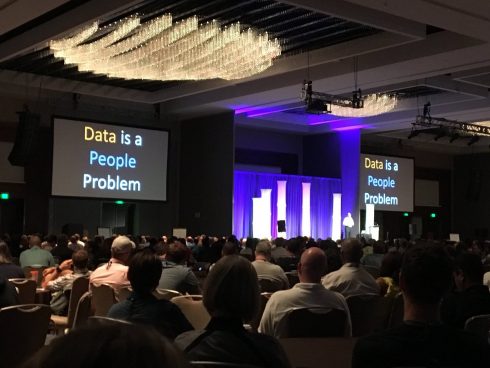
Businesses are looking for new ways to collect, manage and analyze data to make better and more informed decisions, but they are missing the mark. Data is not just about the tools. The number one problem to using data to your advantage is people, according to Troy Magennis, an Agile consultant and founder of Focused Objectives who made a keynote presentation at the 2018 Agile conference in San Diego this week.
According to Magennis, you can collect all the data in the world and make charts and dashboards, but if people don’t understand what you are trying to tell them — it is not going to make a difference.
Magennis opened the keynote with an Agile community call to action: “Having the data isn’t enough. You have to tell the story that leads to the right action.”
That means the way in which we present data in order to get understanding conveyed is very important. “Stop using boring plots,” Magennis stated. “That is not going to convince anything to anyone.” Some ways to do that is to present data in a visually compelling way, and compare it to other scenarios that might make it easier to understand.
Other call to actions Magennis expressed throughout the keynote included:
- Businesses needs to find safer ways to capture and utilize data from teams and organizations
- Safe = better data and happier people
- Businesses needs to find better ways to measure outcome rather than output
- Businesses need to balance our predictability expectations with creativity and novelty
- Businesses need to incorporate new information faster
- Deployment ends speculation
The point Magennis kept stressing is that there needs to be a conversation around data, and so far the industry has been bad at having that conversation. Magennis himself has been subject to bad data practices such as predictability, trying to plan better, and sticking to a narrow range for expectations. That isn’t a good business process because the real value lies in the unpredictability, he explained. “We need to be able to accept in a creative world of doing products and innovations that we are entering uncertain territory,” he said. “We are going to have to accept there is a lot we don’t know and plan with a high degree of uncertainty.”
Organizations are still just in the beginning of this journey of understanding how to do data and how to do it well, and businesses need to move to measuring value and outcomes rather than output, according to Magennis. In order to learn and learn fast, businesses have to be able to accept bad information too, meaning uncertain information that may set you back, but may provide more value than “good information.” Uncertainty is a strategic weapon and being able to embrace unpredictability is a bold movement, he explained.
“You don’t learn as much from an expected outcome as [you do] with an unexpected outcome.”
Forecasting and estimates should not tell you if you are right, they should detect if you are wrong and discover what you missed.
Some best practices include experimenting, using the most recent 10 samples when forecasting with historical velocity or throughput data and starting early. “Forecasting is about knowing when to start,” he explained.
Other points he made included:
- “Give multiple options of investment and implementation
- Give a duration and define what started and complete means
- If the original data is in doubt, know earlier and react faster”






